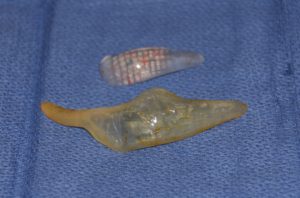
Such midfacial aging has created two basic approaches to addressing this facial aging concern. Historically, a special type of cheek implant has been used, a submalar implant. This type of facial implant sits on the underside of the cheekbone. Because it is placed on the underside of the cheek, it does not accentuate the cheekbone, but rather helps push up fallen cheek tissues. The implant is placed through the mouth through a small incision and is either screwed or sutured to the underside of the cheekbone to hold it in place. As a result of its position, it also helps add fullness to the triangle area under the cheekbone, restoring a subtle and youthful fullness to the midface. This is a simple approach, with few complications, and is a good alternative for those patients that have a minor problem of midfacial aging and can accept a synthetic implant.
An alternative, and more recent approach, has been the midface lift. With this technique, the sagging cheek tissues are actually lifted and resuspended by sutures into a more lifted position. This is done through a lower eyelid approach (and is often done simultaneously with a lower eyelid procedure (blepharoplasty) where the sagging cheek tissues are lifted off of the bone from above. Sutures are then placed through the loosened tissues and are passed underneath the skin and sutures high onto the fascia or bone of the temples. The sutures can be adjusted to control how much lift is achieved. This method restores fullness to the midface by using the patient’s own tissues rather than implant. This is a more complex procedure, with the risk of lower eyelid malpositioning, and is a good choice for those patients with more severe midfacial aging who can accept a longer period of swelling around the eyes after surgery. In the midface lift, make sure you have a plastic surgeon experienced in the procedure due to its higher rate of complications.
Dr Barry Eppley
Indianapolis, Indiana


